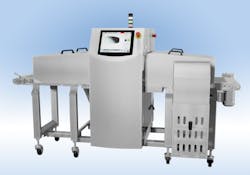OEM APPLICATION NOTE: Moving Customers From Metal Detection to X-ray Inspection
Thermo Fisher Scientific’s Thermo Scientific NextGuard Pro X-ray inspection equipment represents an enhancement to the company’s current NextGuard line, which is designed to make material conveyance more robust and flexible.
NextGuard Pro detects foreign objects in packaged products such as bags, boxes, pouches, and plastic jars to help ensure safety. It can be used in various food applications, including bakery, dairy, and confectionery, or for personal care products as well as healthcare products such as test kits, IV bags, or biomedical supplies.
What makes the machine unique compared to competitive equipment? “The NextGuard platform was designed to cost-effectively move customers from metal detection to X-ray inspection,” says Bob Ries, Lead Product Manager, Metal Detection and X-Ray Inspection, Product Inspection, Thermo Fisher Scientific, Product Inspection. “To achieve this goal it needed to be low-cost, easy-to-use, compact, and reliable. The NextGuard Pro extends the product family by making the material handling, rejection, and shielding more flexible and heavy duty for larger/heavier packages, as well as more robust and in washdown environments.”
Automation and controls are important in making this machine effective, efficient, and unique. Ries explains, “It is effective and efficient so as not to be a bottleneck on a production line. The NextGuard Pro utilizes standard variable frequency drive technology and off-the-shelf gear motors as compared to proprietary components used in the base models.
Specifically, the machine uses an Allen Bradley Powerflex variable frequency drive from Rockwell Automation. “It is a very robust, reliable motor and is a very common component in food motion systems,” says Ries. “We are using it internally in our NextGuard Pro to drive the conveyor.It gives us easy-to-use-and-service variable speed.” The motor/gearbox used in the NextGuard Pro is from SEW-Eurodrive.
Asked why Thermo Fisher selected these particular components from these particular vendors, Ries notes, “Generally speaking, we select components based on experience and standard vendor lists. We have made packaging machines for 65-plus years and have extensive experience in this matter. When asked, we evaluate specific customer component requests and frequently provide these at extra cost.”
The first NextGuard model, the C330, was launched in 2013. Last year, the company introduced its larger NextGuard C500 model. The NextGuard Pro extends the application range of both systems and will be launched globally at Interpack 2017. The company notes there are now 350 NextGuard systems in use commercially at more than 200 customers worldwide in many different applications.
About the Author
Jim Butschli
Features Editor
Jim Butschli
Editor-in-chief, Healthcare Packaging

Leaders relevant to this article:
